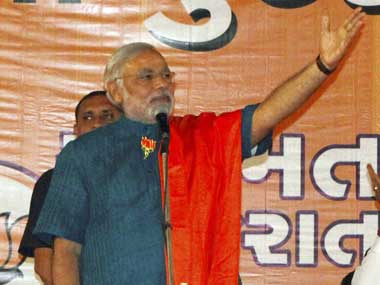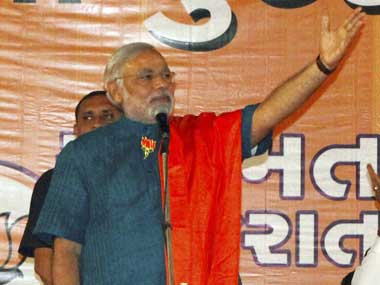A fortnight ago, Narendra Modi was invited by the International Advertising Association (IAA) to deliver a keynote address on Brand India. Most media gushed about the speech – but this piece is not about what he said or didn’t. It’s about how the audience reacted to him and to his speech.[caption id=“attachment_1164159” align=“alignleft” width=“380”]  Gujarat Chief Minister Narendra Modi. PTI[/caption] To begin with, as the invited audience waited for Modi to arrive, we were all milling around the foyer outside the ballroom of the Taj Lands End, where the event was taking place. In normal circumstances, the conversations would be about the speaker, what he was likely to say, what he achieved most recently, and so on. And so it should be. At Modi’s event, there was hardly any talk of Modi. People spoke about ships and sails and sealing wax, and many other things, but little about Modi and what he was likely to say. When Modi came into the hall, the reasons became apparent. Many in the audience stood up immediately, giving Modi a standing applause. Many didn’t, staying rooted to their chairs, with their arms folded in front of them, not risking involuntarily clapping. So it was through Modi’s speech. Each time he delivered a punch line or demonstrated that he was well prepared for the audience (Soft power, ‘inspire, not impress’, ‘Brand India’) a part of the audience applauded like their lives dependent on the act, with the rest sulking in their seats. When his speech ended, it was, again, half a standing ovation. The emcee requested all to remain seated till Modi left the hall, but the ‘sulkers’ would have none of it, leaving the hall before Modi did. And, after he left, the audience broke up into little groups, all discussing advertising and media and gossip. Very little conversation about Modi’s speech. Why? Because the audience was extremely polarized: pro-Modi and anti-Modi. All of us, from advertising and media, can debate and discuss all issues about advertising, media and marketing without worrying about the fallout, but it wasn’t the same with Modi. Over the last few weeks, I’ve seen ‘friends’ on Facebook arguing passionately about things Modi said and didn’t, things Modi did or didn’t; many have gone on till ‘friends’ unfriend each other. This is the state of affairs, even as the election dates for the next Lok Sabha are yet unannounced. As we near the elections, we will know more clearly who is for and who is against Modi. Some of this we will learn through branded apparel that will be worn proudly and overtly . And we will see friends unfriend friends in the real world. We will see business associates delinking from long-standing partners. We will, perhaps, see husbands leaving wives. We have seen many elections, with one political party pitted against another, but none that created divisions as deep as Modi seems to have. That’s what the Congress needs to worry about. Modi’s supporters do not just support Modi, they support him with conviction and passion, they wear their loyalties overtly, they argue vehemently, they evangelise, they attempt to convert, they cajole. And, while doing this, they make one thing clear: you’re with them – or you’re against them. Like their mentor, Modi’s followers know no middle path.
We have seen many elections, with one political party pitted against another, but none that created divisions as deep as Modi seems to have.
Anant Rangaswami was, until recently, the editor of Campaign India magazine, of which Anant was also the founding editor. Campaign India is now arguably India's most respected publication in the advertising and media space. Anant has over 20 years experience in media and advertising. He began in Madras, for STAR TV, moving on as Regional Manager, South for Sony’s SET and finally as Chief Manager at BCCL’s Times Television and Times FM. He then moved to advertising, rising to the post of Associate Vice President at TBWA India. Anant then made the leap into journalism, taking over as editor of what is now Campaign India's competitive publication, Impact. Anant teaches regularly and is a prolific blogger and author of Watching from the sidelines. see more


)
)
)
)
)
)
)
)
)



